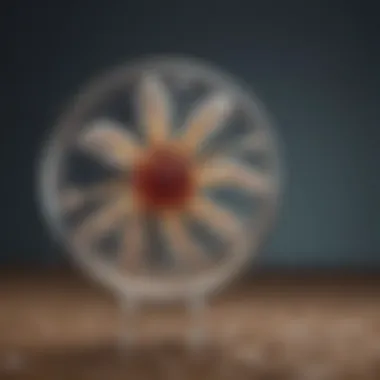Understanding Dog Parasite Giardia: A Comprehensive Guide


Intro
Giardia is a parasite that can have a detrimental effect on our canine companions. Understanding this organism is key for dog owners who want to keep their pets healthy. This section aims to shed light on Giardia, its life cycle, and how it impacts dogs, fostering a deeper understanding of its relevance to pet health.
Understanding Your Pet
Breed Traits
Certain breeds may be more susceptible to infections, including Giardia. Smaller breeds could be at increased risk due to their close contact with the ground and contamination. Rottweilers, Bulldogs, and Dachshunds are noted for higher cases of intestinal parasites. However, no breed is fully immune. Pet owners must remain vigilant regardless of breed.
Common Temperaments
While Giardia affects health, it can also influence a dog’s behavior. Dogs that are experiencing discomfort may become irritable or lethargic. Recognizing these changes can assist in early detection of infection. Remember, a dog’s temperament can indicate health issues.
Special Needs
Some dogs may have special needs related to their health status. If a dog has a compromised immune system, it is even more crucial to watch for signs of Giardia. These dogs may need more frequent veterinary check-ups, and owners should ensure they receive adequate nutrition and care.
Pet Care Essentials
Nutrition and Feeding Guidelines
A strong, balanced diet is crucial for overall canine health. High-quality dog food with proper nutrients helps to bolster the immune system. Stressing the prevention of Giardia should include regular feeding schedules and access to fresh water.
Grooming Tips and Techniques
Grooming is often overlooked but is important in preventing the spread of parasites. Regularly brushing your dog can help remove any debris or feces from their coat that may contribute to the spread of Giardia. Bathing is encouraged, especially after outside activities.
Health and Wellness
Routine veterinary visits should be part of any dog owner’s schedule. Vaccinations and parasite screenings help catch problems like Giardia early. Be aware of any changes in your dog’s health. Awareness is the first step towards treatment and recovery.
Training and Behavior
Basic Training Techniques
Training your dog to follow commands can be beneficial in managing their health. Basic commands can help keep them away from contaminated areas. Commands like “leave it” or “come” can save a dog from ingesting harmful substances.
Behavioral Problems and Solutions
If a dog becomes more aggressive or withdrawn, it could be due to illness. Consulting with a veterinarian is advised if behavioral issues arise. Understanding how Giardia may affect a dog’s mood can help provide effective solutions.
Mental Stimulation Activities
Keeping a dog mentally engaged helps to distract from illness. Puzzles and interactive toys can provide much-needed stimulation. This also aids in keeping their mind occupied, reducing stress while they battle any infections.
Engaging with Your Pet
Interactive Games and Toys
Games encourage healthy bonding and distract from discomfort. Fetch or hide-and-seek can be fun activities that keep an affected dog engaged without too much exertion.
Safe Outdoor Activities
Prioritize safe areas for outdoor play. Avoiding potential Giardia contamination points, like standing water, is important. Exploring secure dog parks or having controlled backyard space can help minimize risks.
Family-Friendly Pet Interactions
Including family members in pet care is essential. Teach children to recognize symptoms of illness or discomfort in pets. This inclusiveness can foster a supportive environment for both dogs and humans, enhancing overall well-being.
Pet Adoption and Integration


Choosing the Right Pet for Your Lifestyle
Adopting a dog requires understanding the responsibility involved. Be mindful of health-related factors when choosing a dog. Understand how to care for specific breed needs and environmental considerations.
Preparing Your Home for a New Pet
When adopting, ensure your home is safe for the new pet, free from hazards. Keeping areas clean can help prevent future infections. If there are existing pets, careful integration is required to ensure everyone's well-being.
Tips for Smooth Preface
Introduce the new dog to existing pets slowly. Monitor all interactions closely, especially if any pet seems unwell. This gradual approach can help prevent stress and facilitate smoother connections between pets.
Understand the significance of regular veterinary check-ups. They are vital in maintaining a healthy pet and preventing issues like Giardia. Early detection can save both health and finances in the long run.
Foreword to Giardia
Giardia is a highly significant parasite that merits close attention from dog owners. Understanding this organism is key for maintaining the well-being of our pets. In this section, we explore the fundamental aspects of Giardia, its relevance to canine health, and the potential risks associated with infection.
What is Giardia?
Giardia is a microscopic parasite that infects the intestines of various animals, including dogs. It is known scientifically as Giardia intestinalis, and it belongs to the group of protozoan parasites. This organism exists in two forms: the trophozoite, which is the active feeding stage, and the cyst, which is the dormant, infective stage. The cysts are resistant to harsh environmental conditions, allowing them to survive in water and soil, making transmission easy.
Dogs can become infected with Giardia through contaminated food, water, or surfaces. Symptoms of infection often include diarrhea, weight loss, and lethargy. It is important to note that not all dogs infected with Giardia will show symptoms but they can still shed cysts in their feces, further contributing to the cycle of infection.
Historical Context of Giardia in Dogs
The history of Giardia as a parasite affecting dogs dates back several decades. Discoveries highlight its presence in canines around the world, with increasing reports of cases over time. For many years, the understanding of Giardia was limited, and it was often thought to be a problem restricted to specific breeds or populations.
Research over the years has shown that Giardia can affect dogs regardless of age, breed, or living conditions. In fact, studies indicate that Giardia is one of the most frequently diagnosed intestinal parasites in dogs, underscoring the importance of awareness among pet owners. The growing incidence of cases emphasizes the need for preventive measures, timely diagnosis, and effective treatment options.
As our knowledge about Giardia evolves, it has become clear that vigilance is paramount in the realm of canine health.
Understanding the historical context of Giardia allows for better risk management and treatment strategies, helping dog owners to protect their pets from infection. Educating oneself about this parasite will empower pet owners to take proactive steps, safeguarding their furry companions against potential harm.
Life Cycle of Giardia
The life cycle of Giardia is a crucial aspect in understanding this parasite and its impact on canine health. Comprehending the various stages of Giardia not only helps in diagnosing and treating infections but also informs preventive measures that dog owners can implement. Each stage of this life cycle plays a significant role in the transmission and persistence of the infection in a pet's environment.
Trophozoite Stage
The trophozoite stage is the active form of Giardia. It is typically found in the intestines of infected dogs. In this stage, Giardia exists as a motile organism, using its flagella to move in the intestinal lumen. This motility enables it to adhere to the intestinal wall, where it can interfere with nutrient absorption.
Trophozoites replicate through binary fission, meaning that one organism divides into two. This rapid multiplication often leads to a higher parasitic load, promoting the severity of the symptoms in infected dogs. Common signs during this stage may include diarrhea, weight loss, and vomiting. Recognizing these symptoms early is critical for effective intervention.
Cyst Stage
The cyst stage represents the dormant form of Giardia. During this phase, the parasite encapsulates itself in a protective shell, allowing it to survive outside the host in harsh environmental conditions. It can persist in the environment for several months, making it a significant concern for dog owners, especially in areas where dogs frequent.
Cysts are shed in the feces of infected dogs, contaminating the soil, water, and food sources. This stage poses a substantial risk for infection, as other animals or humans may ingest these cysts unknowingly. Transmission often occurs when dogs consume contaminated water or food, making awareness and hygiene practices essential for prevention.
Cycle of Infection
Understanding the cycle of infection of Giardia is essential for recognizing how infections spread and recur. The cycle begins when cysts are ingested by a susceptible host, such as a dog. Once in the intestines, the cysts excyst to release trophozoites, starting the cycle anew.
As trophozoites multiply and attach to the intestinal wall, they ultimately initiate shedding of cysts back into the environment through feces. This continuous cycle means an infected dog can easily reinfect itself or pass the parasite to other animals, particularly in areas where they share resources like parks or yards.
Proper sanitation is a key measure for breaking this cycle of infection. Regular cleaning of areas where dogs roam, along with monitoring their water sources, significantly reduces the risk of Giardia infection.
By understanding the life cycle of Giardia, pet owners enhance their ability to manage and prevent potential infections in their dogs. A detailed knowledge of both the trophozoite and cyst stages aids in the identification of symptoms and appropriate responses to ensure the well-being of canine companions.
Transmission of Giardia


Understanding the transmission of Giardia is vital for pet owners. This parasite can lead to serious health issues in dogs if not managed effectively. Knowing how Giardia spreads empowers owners to take appropriate preventive measures, ensuring the wellbeing of their pets. By exploring the various modes of transmission, we can identify risk factors and implement strategies to minimize exposure.
Environmental Factors Contributing to Infection
Certain environmental conditions can heighten the risk of a Giardia infection. Factors such as climate, habitat, and sanitation play key roles. Wet and warm environments are conducive to the survival of Giardia cysts. Areas with stagnant water or poorly drained soils can harbor these cysts, leading to greater exposure for dogs. Additionally, dogs living in or near unsanitary conditions, such as those commonly found in shelters or kennel environments, face a higher likelihood of encountering the parasite.
Pet owners should also be aware of the role that dog parks and play areas can play in the spread of Giardia. Many dogs interact in close quarters in these locations, raising the potential for fecal contamination. Proper awareness of these environments can help guide dog owners in maintaining a healthier space for their pets.
Role of Contaminated Water
Water sources contaminated with Giardia are significant contributors to transmission. Dogs often consume water from sources such as lakes, rivers, and even puddles. These water sources can become contaminated with cysts from feces of infected animals. It is essential to prevent dogs from drinking from these potentially hazardous sources. Providing clean, fresh water at all times can mitigate the risk of exposure.
To further reduce risks, pet owners should regularly monitor water quality in their surroundings. If water sources are known to be contaminated or if a Giardia outbreak is reported in a local area, it is prudent to temporarily avoid those areas.
Impact of Socialization and Group Play
Social interactions among dogs can also facilitate the spread of Giardia. When dogs play together, they can transmit the parasite through direct contact or indirectly through contaminated surfaces. Young dogs are particularly vulnerable as they often have weaker immune systems and are more social in nature. As a result, the risk of transmission increases during playdates or at training classes.
To help reduce these risks, dog owners should observe their pets’ behavior in social settings. If a dog shows signs of illness, such as diarrhea or lethargy, it is wise to limit socialization until clinical concerns are addressed. Regularly scheduling vet check-ups can ensure that pet owners are aware of potential health issues early.
Informed pet owners play a crucial role in controlling Giardia's transmission. By recognizing various transmission factors, they can safeguard their dogs from potential infection.
Identifying Giardia Infections in Dogs
Identifying Giardia infections in dogs is crucial for ensuring the health and well-being of our furry companions. Early recognition can lead to timely treatment, preventing further health complications. Understanding the signs and symptoms of Giardia infection enhances a dog's recovery and reduces the risks of transmission to other pets or humans. In this section, we will discuss the common symptoms pet owners should observe as well as the diagnostic procedures that veterinarians typically employ.
Common Symptoms to Observe
Recognizing the symptoms of Giardia in dogs is the first step towards effective treatment. Common signs associated with Giardia infection include:
- Diarrhea: This is the most prominent symptom. The stool may be watery, and in some cases, it could have a foul odor.
- Vomiting: Dogs with Giardia may vomit, suggesting a disturbance in their gastrointestinal tract.
- Weight Loss: Chronic and untreated Giardia can lead to weight loss due to malabsorption of nutrients.
- Lethargy: Infected dogs often exhibit reduced energy levels and may seem more tired than usual.
- Abdominal Pain: Some dogs may demonstrate signs of discomfort, such as whining or reluctance to be touched.
These symptoms can sometimes be vague or mistaken for other conditions. Therefore, monitoring your dog's health closely is essential. If Giardia is suspected, prompt veterinary consultation is advised.
Diagnostic Procedures
Veterinarians use several diagnostic procedures to confirm the presence of Giardia. Understanding these methods can help pet owners engage more effectively in the health management of their dogs. Common diagnostic steps include:
- Fecal Examination: This is the most common procedure. A fresh stool sample is analyzed under a microscope to identify Giardia cysts.
- Antigen Testing: This test detects specific proteins associated with the parasite. It can be more sensitive than standard fecal tests.
- PCR Testing: Polymerase Chain Reaction testing is utilized for precise diagnosis. It amplifies genetic material from Giardia, making it easier to detect.
Accurate diagnosis is crucial. Misidentifying Giardia can result in inappropriate treatment and prolonged illness.
Treatment Options for Giardia Infections
Addressing Giardia infections promptly is crucial for the health of dogs. Proper treatment helps alleviate symptoms and prevent further transmission. There are several key components of treatment that dog owners should understand well. These include antiparasitic medications and supportive care, which both play significant roles in recovery.
Antiparasitic Medications
Antiparasitic medications are the cornerstone of treatment for Giardia infections. The most commonly prescribed drugs include Metronidazole and Fenbendazole. Both of these medications target the parasite effectively and are typically well-tolerated by dogs.
- Metronidazole: This medication disrupts the DNA of the Giardia parasite, leading to its death. A standard course lasts for about five days. Side effects are rare but can include gastrointestinal issues or lethargy.
- Fenbendazole: Another effective option, Fenbendazole works by inhibiting the metabolism of the parasite. It is usually administered over a three-day course and may be given in combination with other treatments for better outcomes.
Veterinarians will decide on the best medication based on the severity of the infection and the dog's overall health. Regular follow-ups are necessary to ensure the infection is fully resolved.
Supportive Care and Nutrition
In addition to antiparasitic treatments, supportive care is crucial for a dog's recovery from Giardia. Many dogs experience dehydration and other nutritional deficiencies during an infection. Therefore, placing emphasis on supportive care can enhance the healing process.
- Hydration: Ensuring that the dog stays well-hydrated is essential. This can be achieved by offering plenty of fresh water. In severe cases, intravenous fluids may be required to treat dehydration.
- Dietary Adjustments: Feeding a bland diet can help ease gastrointestinal upset. Foods like boiled chicken or rice are often recommended. Gradually reintroducing regular food is advised as the dog begins to improve.
In summary, treating Giardia infections involves a combination of targeted antiparasitic medications and supportive care. Pet owners must be proactive in managing their dog's health and follow through with veterinary guidance for the best outcomes. Regular monitoring and adjustments in care will assist in successful recovery.


It is important to prioritize both antiparasitic medications and supportive care when addressing Giardia infections in dogs to ensure a comprehensive approach to treatment.
Preventive Measures for Dog Owners
Preventing Giardia infections in dogs is a crucial aspect of responsible pet ownership. By implementing effective preventive measures, dog owners can significantly reduce the risk of infection for their pets, contributing to their overall health and well-being. This section focuses on hygiene practices, the importance of regular veterinary check-ups, and monitoring water sources to keep dogs safe from Giardia and other parasites.
Hygiene Practices
Maintaining high cleanliness standards is fundamental in preventing Giardia and other infections. Healthy hygiene habits can drastically cut the chances of parasite transmission. Pet owners should start by ensuring that their dog’s living space is kept clean. Regularly disinfecting areas where the dog spends time is key.
- Regularly clean dog bedding: Wash and change bedding periodically to eliminate any potential cysts.
- Dispose of feces promptly: Cleaning up after your pet should be immediate, preventing the spread of cysts in the environment.
- Hand hygiene: Washing hands after handling pets or cleaning their spaces connects directly to reducing the risk of zoonotic infections.
Using safe cleaning products is essential to ensure that harmful chemicals do not pose a risk to your pet.
Regular Vet Check-ups
Routine veterinary visits are critical for early detection and management of Giardia infections. These check-ups facilitate a thorough examination of the dog's health and provide an opportunity for proper fecal testing. Regular visits allow for:
- Early identification of potential health issues related to parasites.
- Vaccination updates that can help boost overall immunity, aiding in the fight against infections, including Giardia.
- Consultation on diet and nutrition, which supports a stronger immune system, making it less hospitable for parasites.
Pet owners should aim for at least annual veterinary visits, while puppies and potentially infected dogs may benefit from more frequent evaluations.
Monitoring Water Sources
Water quality is a significant factor in preventing Giardia infections. Contaminated water represents a primary transmission route for this parasite. Here are some practical considerations for pet owners:
- Provide fresh, clean drinking water: Regularly change your dog's water and ensure it is free from contamination.
- Avoid stagnant water: Dogs should not drink from puddles, streams, or unsupervised outdoor water sources, as these can be breeding grounds for Giardia cysts.
- Use filtered water when possible, especially for dogs who frequently visit areas where parasitic contamination is a concern.
By establishing a reliable water source and preventing access to potentially contaminated areas, dog owners can reduce the risks posed by Giardia infection.
Regular preventive measures are the backbone of responsible pet ownership. Taking steps toward hygiene, using veterinarian services, and ensuring clean water can help protect dogs from the threat of Giardia infections.
Misconceptions about Giardia
The subject of misconceptions surrounding Giardia is crucial in understanding how to properly care for dogs affected by this parasite. Misunderstandings can lead to undue panic or neglect regarding canine health. By addressing these misconceptions directly, pet owners can make informed decisions and take the right actions to protect their dogs. This section aims to clarify common beliefs related to Giardia, which will enhance awareness and comprehension for all dog owners.
If One Dog Gets Giardia, All Dogs Will Get It
A prevalent belief among dog owners is that if one dog in a household is diagnosed with Giardia, all other dogs will inevitably contract the parasite. While it is true that Giardia is contagious, the reality is more nuanced. The transmission of Giardia does not happen automatically among dogs. Factors include the immune status of the dogs involved and their proximity to the contaminated environment.
If one dog has an active infection, it does increase the risk for other dogs, but they are not guaranteed to also get infected. Preventive measures, such as maintaining cleanliness and proper hygiene practices, can significantly reduce this risk. For example, cleaning up feces promptly and ensuring that shared spaces are sanitized are effective actions to take. Each dog’s overall health and immune response will also play a role in susceptibility. Thus, understanding that not all dogs will become infected offers a clearer perspective and can reduce unnecessary fear among pet owners.
Giardia is Only a Concern for Puppies
Another common misconception is that Giardia poses a threat only to puppies. This idea is misleading. While puppies, due to their developing immune systems, can be more vulnerable to infections, adult dogs are equally at risk. Each dog’s health status, such as pre-existing conditions and the overall strength of its immune system, will determine susceptibility to Giardia.
Additionally, adult dogs can also harbor Giardia without displaying noticeable symptoms. These asymptomatic cases can contribute to the spread of the parasite, especially in environments where multiple dogs interact. Therefore, neglecting the risk for adult dogs of all ages can lead to wider outbreaks.
Awareness of Giardia’s impact on all dogs encourages routine veterinary check-ups and swift action if symptoms arise. Such knowledge fosters a comprehensive approach to managing dog health and welfare. Overall, it's important to dispel the notion that only puppies are at risk to safeguard the health of dogs at every stage of life.
Culmination
Understanding Giardia and its implications for dogs is vital for every pet owner. This article has provided a comprehensive overview of the parasite, detailing its life cycle, transmission methods, symptoms, and treatment options. The depth of this exploration highlights not just the medical aspects, but also the behavioral and environmental contexts that play substantial roles in preventing infections. Recognizing the symptoms early and seeking prompt treatment can save not just your pet a great deal of discomfort, but also ensure that Giardia does not spread within your local pet community.
The section on misconceptions clarifies common misunderstandings, which can lead to unnecessary anxiety for dog owners. Addressing these issues allows for a more informed approach to pet care, removing the stigma from Giardia. Moreover, acknowledging Giardia as a condition that can affect not only puppies but dogs of all ages is crucial. Awareness, informed actions, and regular health checks create an effective defense against outbreaks. By fostering a thorough understanding of Giardia, pet owners can contribute to the overall health and well-being of their canine companions.
Recap of Key Points
- Giardia is a prevalent gastrointestinal parasite affecting dogs.
- Its life cycle involves both trophozoite and cyst stages.
- The parasite can spread through contaminated water and environments, especially in social settings.
- Common symptoms include diarrhea, vomiting, and weight loss.
- Diagnostic procedures often include stool tests and possibly blood tests.
- Antiparasitic medications, alongside supportive care, are typically effective in treatment.
- Prevention strategies include diligent hygiene practices, regular veterinary check-ups, and monitoring water sources, especially in places where multiple dogs gather.
Importance of Awareness and Action
The focus on awareness regarding Giardia is fundamental for effective pet care. Many dog owners may dismiss initial symptoms, inadvertently allowing the parasite to worsen. Being alert and attentive to changes in your pet's health can make a difference in their recovery process.
Taking proactive steps can significantly reduce the risk of transmission. Educating oneself on proper hygiene practices and maintaining a clean environment for your dog minimizes exposure. Furthermore, understanding that Giardia can affect any dog, not just the young or immune-compromised, emphasizes the need for collective vigilance among pet owners.
Awareness leads to action, and when informed dog owners take the necessary steps, it fosters a safer community for all pets. For additional resources on Giardia and canine health, you can visit Wikipedia or check discussions on Reddit for insights from fellow pet owners.



